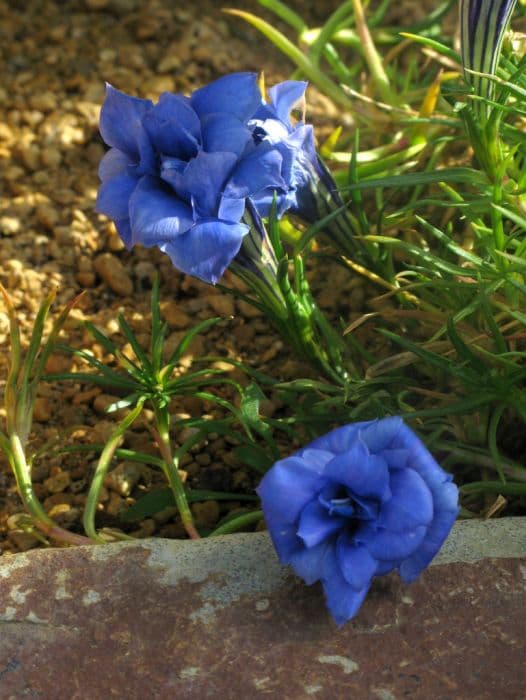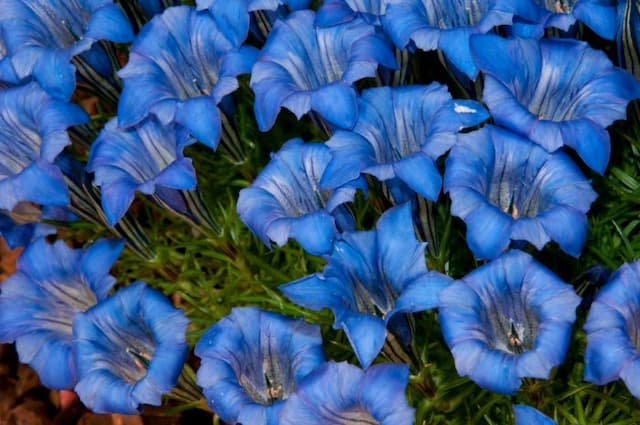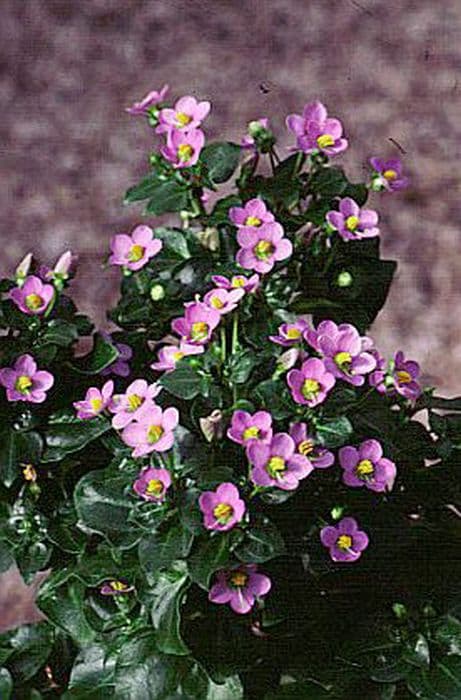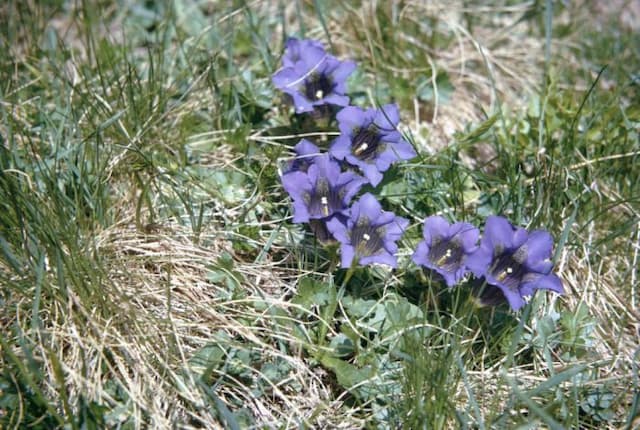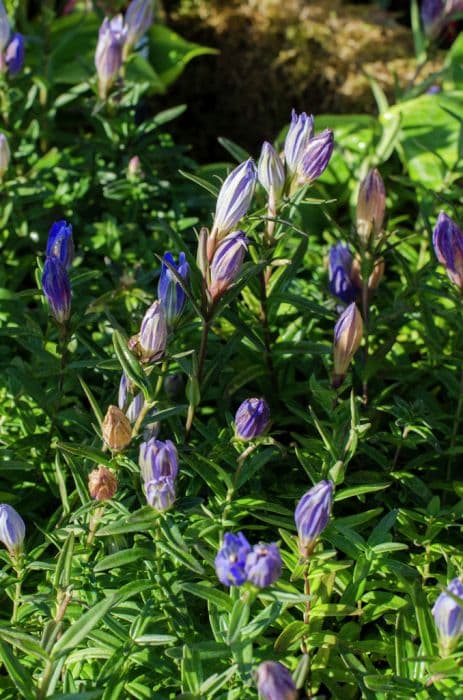Spring gentian Gentiana verna

ABOUT
Gentiana verna, commonly known as the spring gentian, is a perennial plant known for its strikingly vibrant blue flowers. The leaves of spring gentian are glossy, forming a basal rosette—a circular arrangement close to the ground—from which the flowers emerge. These green leaves are usually lance-shaped or ovate, with smooth margins, providing a lush backdrop for the blooms. The flowers themselves are the main attraction of the plant, boasting a deep, almost electric blue hue that can also appear in shades ranging from purplish-blue to rarely white. Each flower is shaped like a trumpet or a bell and is comprised of five fused petals that form a star-like pattern when viewed from above. The center of the flower often displays delicate greenish or white patterns, adding to the visual appeal. Furthermore, the petals of spring gentian are characterized by their length, which allows the flowers to stand out gracefully against the foliage. Spring gentian blooms typically have a prominent appearance, despite their solitary growth pattern, without branching into multiple stems from the base. The overall impression of the plant is one of compactness and vibrancy, making spring gentian a treasured species for garden enthusiasts and a sought-after sight in its natural habitat during its flowering season.
About this plant
 Names
NamesFamily
Gentianaceae
Synonyms
Spring Gentian, Mountain Gentian, Blue Gentian
Common names
Gentiana verna var. brachyphylla, Gentiana verna var. pontica, Gentiana verna var. tergestina, Gentiana brachyphylla, Gentiana tergestina, Gentiana pontica.
 Toxicity
ToxicityTo humans
Spring gentian, or Gentiana verna, is generally not considered toxic to humans. There are no known toxic effects from ingesting this plant. Therefore, there are no specific symptoms of poisoning associated with it. However, it's always wise to exercise caution and avoid consuming plants unless they are known to be safe and are prepared correctly.
To pets
Spring gentian is not commonly known to be toxic to pets. Therefore, if a pet ingests part of this plant, it is unlikely to cause poisoning. However, individual animals might have sensitivities or allergic reactions to plants that are not typically toxic, so it's always best to keep an eye on your pet and consult a veterinarian if you notice any unusual symptoms after ingestion.
 Characteristics
CharacteristicsLife cycle
Perennials
Foliage type
Evergreen
Color of leaves
Green
Flower color
Blue
Height
0.5 feet (15 centimeters)
Spread
0.5 feet (15 centimeters)
Plant type
Herb
Hardiness zones
3
Native area
Europe
Benefits
 General Benefits
General Benefits- Ornamental value: Spring gentian is known for its striking blue flowers, adding aesthetic appeal to gardens and natural landscapes.
- Drought tolerance: Once established, it is fairly tolerant of drought, making it suitable for rockeries and low-water gardens.
- Wildlife attraction: Its flowers attract pollinators such as bees and butterflies, supporting local ecosystems.
- Cultural significance: Spring gentian has been used in traditional celebrations and folklore, particularly in alpine regions.
- Soil stabilization: As a low-growing perennial, it can help prevent soil erosion on slopes and in rough terrain.
- Adaptability: It can thrive in poor soils and at high altitudes, which makes it versatile for various landscape uses.
 Medical Properties
Medical Properties- Anti-inflammatory: Gentiana verna has been traditionally used to reduce inflammation.
- Digestive aid: It is known for its potential to aid digestion and stimulate appetite.
- Hepatoprotective: The plant may protect the liver and improve liver function.
- Antioxidant: Contains compounds that may help to neutralize free radicals.
- Antipyretic: It has been used to lower fever.
- Bitter tonic: The bitter properties of Gentiana verna may stimulate gastric secretions and improve digestive health.
 Air-purifying Qualities
Air-purifying QualitiesThis plant is not specifically known for air purifying qualities.
 Other Uses
Other Uses- Gentiana verna, commonly known as spring gentian, has been traditionally used as a natural fabric dye, imparting a blue or green hue depending on the mordant used.
- The flowers of spring gentian can be crystallized and used as edible decorations for desserts, providing a unique aesthetic and mild flavor.
- The plant's intense blue flowers are a natural source for pigment and can be utilized in botanical paint-making for artists seeking organic colorants.
- Gardeners cultivate spring gentian to attract pollinators such as bees and butterflies, due to its vivid coloring and nectar-rich flowers.
- Enthusiasts of miniature gardening and fairy gardens use spring gentian for its small size and bright color to create whimsical, scale-appropriate plantings.
- Professional photographers and artists often make use of spring gentian in their compositions because of its striking color and association with springtime scenery.
- The plant’s roots, rich in compounds that absorb ultraviolet light, have been explored for use in natural sunscreens.
- In alpine and rock gardens, spring gentian is valued for its ability to thrive in poor soils, making it useful for erosion control on slopes.
- Educators use spring gentian as a teaching tool in botany and ecology classes to illustrate plant adaptation to harsh, mountainous environments.
- Culinary experimenters sometimes infuse syrups or vinegars with spring gentian flowers to create distinctive, color-tinted flavors.
Interesting Facts
 Feng Shui
Feng ShuiSpring gentian is not used in Feng Shui practice.
 Zodiac Sign Compitability
Zodiac Sign CompitabilitySpring gentian is not used in astrology practice.
 Plant Symbolism
Plant Symbolism- Persistence and resilience: Gentiana verna, commonly known as spring gentian, often grows in challenging alpine environments, which symbolizes its ability to persist and thrive in difficult conditions.
- Victory over obstacles: The flower's ability to emerge through the hard soils of high altitudes signifies overcoming challenges or obstacles in one's life.
- Appreciation of beauty: Spring gentian is known for its vibrant blue color, symbolizing an appreciation for natural beauty and the small but beautiful aspects of life.
- Enduring love: As a plant that endures harsh conditions, it can also represent a love that endures through hard times.
- Strength: The robust nature of this plant in its natural habitat is a symbol of inner strength and fortitude.
 Water
WaterSpring Gentian requires consistent moisture and should be watered whenever the top inch of soil feels dry to the touch. In general, this may mean watering once or twice a week, varying with climate conditions. It is best to water gently at the base of the plant to avoid splashing the foliage, using around one gallon of water per week for an established plant in moderate climates. Adjust the amount depending on rainfall, temperature, and the specific needs of your plant, ensuring adequate drainage to prevent root rot.
 Light
LightSpring Gentian thrives in full sun to partial shade, benefiting from a position that receives morning sunlight with some afternoon shade, especially in hotter regions. The ideal spot would protect the plant from intense midday sun, which could harm the delicate flowers and foliage. Ensure that wherever you place your Spring Gentian, it gets several hours of quality light daily.
 Temperature
TemperatureSpring Gentian prefers cool climates and is hardy in temperatures ranging from 20 to 75 degrees Fahrenheit. It can survive short periods below freezing but should be protected from harsh winter winds. The optimal growing temperature for Spring Gentian lies within 50 to 65 degrees Fahrenheit, making it suitable for cooler areas or higher elevations.
 Pruning
PruningPrune Spring Gentian in late winter or early spring to remove dead or damaged foliage and encourage new growth. Deadheading spent flowers can also promote a second bloom. Pruning is generally light, and it's important not to cut back the plant too harshly. The best time for pruning is before new growth starts and after the risk of severe frosts has passed.
 Cleaning
CleaningNot needed
 Soil
SoilSpring gentian thrives in a well-draining, loamy or sandy soil with a slightly acidic to neutral pH of 6.0-7.0. A mix containing peat, coarse sand, and loam with some added leaf mold is ideal for this alpine plant.
 Repotting
RepottingSpring gentian rarely needs repotting since it grows slowly and enjoys being somewhat root-bound. You should consider repotting only if the plant has outgrown its current pot or every 2-3 years to refresh the soil.
 Humidity & Misting
Humidity & MistingSpring gentian prefers moderate humidity levels, as it is native to mountainous terrains where the air can be quite fresh. Aim for a humidity level around 50%, which should be adequate for its growth.
 Suitable locations
Suitable locationsIndoor
Ensure bright, indirect light and cool temperatures for indoor spring gentian.
Outdoor
Plant in partial shade with well-draining soil and protect from hot sun.
Hardiness zone
3-8 USDA
 Life cycle
Life cycleGentiana verna, commonly known as the spring gentian, begins its life cycle as a seed which germinates in late spring. Seedlings develop a taproot and a small rosette of leaves close to the ground, which allows the plant to survive in its alpine habitat. The following spring, the rosette enlarges, and the plant produces flowering stems bearing vivid blue flowers, which are pollinated by insects attracted to their color and nectar. After pollination, the flowers develop into capsules containing numerous small seeds. Throughout the summer, these seeds mature and are eventually dispersed by wind or rain. The plant then overwinters as a rosette, with perennation enabled by the taproot and may produce flowers again in the next season, completing its perennial life cycle.
 Propogation
PropogationPropogation time
Spring to early summer
Propogation: The most popular method of propagating Gentiana verna, commonly known as Spring Gentian, is by seed. The ideal time to sow seeds is in autumn, as this aligns with the plant's natural cycle, allowing for stratification during the winter months. Stratification is a process of chilling seeds to simulate winter conditions, which breaks the seed dormancy and promotes germination when the temperatures rise in spring. The seeds should be sown on the surface of a well-drained soil mix and lightly covered with soil. Maintaining moisture is critical, but the soil should not be waterlogged. It is also essential to provide bright but indirect light and patience, as gentians can be slow to germinate and grow. The process can take several weeks to months, and care should be taken not to disturb the seeds during this time.
